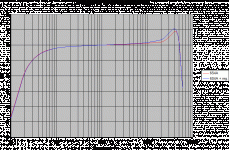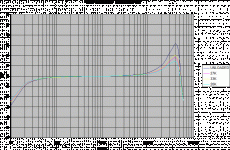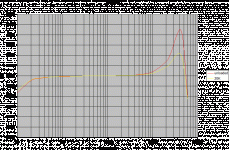I'm still testing driver candidates, so haven't listened to anything yet. The amp will be an IT coupled 300B SE. The 6C45Pi is the last tube in the list, though I may go and fiddle with the 46 again.
So far the successful candidates are the 6S4A, 12BH7 and the ECC99 with loaded secondary. I would like to stay with a tube that has sufficient gain for a two stage amp.
The 6S4A is down 1dB at 30Hz through the IT. Will you notice this? Possibly, depending on your speaker response et al. I played with bypass cap values on the ECC99 and found that you can tweak the low end response somewhat by using smaller than ideal values, which produces a low frequency resonance and a slightly tilted up low end response. I haven't tried that with the 6S4A.
So far the successful candidates are the 6S4A, 12BH7 and the ECC99 with loaded secondary. I would like to stay with a tube that has sufficient gain for a two stage amp.
The 6S4A is down 1dB at 30Hz through the IT. Will you notice this? Possibly, depending on your speaker response et al. I played with bypass cap values on the ECC99 and found that you can tweak the low end response somewhat by using smaller than ideal values, which produces a low frequency resonance and a slightly tilted up low end response. I haven't tried that with the 6S4A.
I'm wondering whether using a series RC network in parallel with either the primary (reducing HF load and hence gain) or secondary (here as a load) might be a worthwhile experiment.
I have also heard in some cases lately that people are using tubes with much higher rp's than would normally be the case (for a given primary impedance) to drive IT transformers precisely because of the ultrasonic rise in response. (A number of people in my local tube group have been using IT for a long time and have used this approach successfully.) It does place rather onerous demands on primary inductance and transformer construction particularly to reduce interwinding capacitances.
Some additional R in series with the primary will also reduce the ultrasonic resonance at the expense of overall gain as will higher winding resistances.
I have also heard in some cases lately that people are using tubes with much higher rp's than would normally be the case (for a given primary impedance) to drive IT transformers precisely because of the ultrasonic rise in response. (A number of people in my local tube group have been using IT for a long time and have used this approach successfully.) It does place rather onerous demands on primary inductance and transformer construction particularly to reduce interwinding capacitances.
Some additional R in series with the primary will also reduce the ultrasonic resonance at the expense of overall gain as will higher winding resistances.
Kevin, that's why I'm leaning toward the 6S4A (rp = 3.7K) and 12BH7 (rp = 5.3K), little or no HF peaking and sufficient gain for my purposes. As you state, any type of loading will reduce gain. The flattest response from let's say 40Hz - 10kHz is the ECC99 so I will continue to play with secondary loading and try a series RC across the secondary.
Have any of your IT users commented on the sound of a higher rp tube versus lower rp with it's HF peaking? Does it tend to harden the sound? I may try something in the 6 -7K range at a lower current to maximize the inductance of the IT.
I've got a 6C45Pi in circuit now. I believe the rp is <1K so I may try low current (15 mA or so) and parallel the windings. This will reduce the inductance of the A-105 to ~15H. We'll see what happens.
Have any of your IT users commented on the sound of a higher rp tube versus lower rp with it's HF peaking? Does it tend to harden the sound? I may try something in the 6 -7K range at a lower current to maximize the inductance of the IT.
I've got a 6C45Pi in circuit now. I believe the rp is <1K so I may try low current (15 mA or so) and parallel the windings. This will reduce the inductance of the A-105 to ~15H. We'll see what happens.
jazzbo said:Kevin, that's why I'm leaning toward the 6S4A (rp = 3.7K) and 12BH7 (rp = 5.3K), little or no HF peaking and sufficient gain for my purposes. As you state, any type of loading will reduce gain. The flattest response from let's say 40Hz - 10kHz is the ECC99 so I will continue to play with secondary loading and try a series RC across the secondary.
Have any of your IT users commented on the sound of a higher rp tube versus lower rp with it's HF peaking? Does it tend to harden the sound? I may try something in the 6 -7K range at a lower current to maximize the inductance of the IT.
I've got a 6C45Pi in circuit now. I believe the rp is <1K so I may try low current (15 mA or so) and parallel the windings. This will reduce the inductance of the A-105 to ~15H. We'll see what happens.
Sounds like you are proceeding down the same line of thought.. Haven't heard anything about hardening of the sound using higher rp tubes to drive a given transformer.
Should be interesting to see what happens with the 6C45pi and parallel windings. I would think that the 5842 would be pretty reasonable in this configuration as well and at about the same current.
Your experiments are quite interesting to me because I am trying to decide whether I will use an IT in my next amplifier which is contemplated to be VT4C running in A2.. My last IT coupled design wasn't entirely to my liking although my client liked it well enough.. (Tango iron)
jazzbo said:Kevin, I meant does the tube with the lower rp and HF peaking harden the sound...
I've read (RDH4?) that loading the secondary increases transformer distortion. kmaier says no, it lowers it. Any opinion on this?
Warning - Comments below are my largely UNSUBSTANTIATED opinions:
I think in terms of hardening the sound that all depends where the resonant peak occurs in the response band. Theoretically ultrasonic peaking should not be audible IMO, unless the peaking starts in the region where you can hear it, but I suspect it will depend heavily on your speaker's HF response - if you have bright sounding metallic dome tweeters it could well make them sound worse. I don't have enough experience to make a judgment here I think.. I'm also assuming that the resonance could cause pretty substantial phase shift in band which if you are interested in phase coherent speaker designs might defeat the point - however I believe this is still linear phase so in practice probably not a big issue, but again this is a more than a bit of a guess, and might not be worth the words on this page..
 So take my comments with a large grain of salt, I might be all wet.
So take my comments with a large grain of salt, I might be all wet.The one comment I can make about recent IT coupled amplifiers designed by others in my group is that they sounded really good. No hint of hardness or glare..
My one foray in this direction was interesting, but it was long enough ago that I cannot say why I was less than completely impressed and it might just have been the very peaky speakers I was using or some other design choice based on my level of experience at the time.. I'm planning to try again and will probably use a 45 to drive the IT unless I decide forgo A2 and select a 2 stage topology with a 5842 instead...
I think your second question could be very transformer dependent. Dave Slagle and other knowledgeable types advocate not using loading resistors on the secondary for this reason, and allege that only inferior transformers exhibit improved performance when loaded. I don't know the answer to this question, but suspect that complex transformer models would show some level of resistive damping to be useful in almost all cases - again a guess, and certainly not needed with an ideal transformer, does an ideal transformer exist? No, but some may approach the ideal closely enough not to benefit from significant loading.
Parts of your inner ear that deal with balance can easily hear
up to beyond 50K. Bad interactions between the brain and
this part of the ear are sometimes associated with Tinnitus.
Fortunately, there is no easy acoustic path to these organs.
I still wouldn't build an amp that assumes no harm will ever
come of letting ultrasonic frequencies pass.
up to beyond 50K. Bad interactions between the brain and
this part of the ear are sometimes associated with Tinnitus.
Fortunately, there is no easy acoustic path to these organs.
I still wouldn't build an amp that assumes no harm will ever
come of letting ultrasonic frequencies pass.
Hi Jazzbo,
Dragging up this thread again. It would appear that the A-105 may be difficult to mate with an appropriate driver. Between it's 5K primary impedance and 15ma max current limitation, it limits your selection greatly.
I did some penciling on the 71A plate curves and it appears that biasing at 15ma is a good match. Load line worked out to ~4600 ohms. Assuming the 1:2 ratio, it should be able to push enough power to drive a 300B with over 200 volts peak-to-peak on the secondary wired in series. I'm hoping to try a prototype in December for this.
Have you reached any conclusions yet for your particular application?
Regards, KM
Dragging up this thread again. It would appear that the A-105 may be difficult to mate with an appropriate driver. Between it's 5K primary impedance and 15ma max current limitation, it limits your selection greatly.
I did some penciling on the 71A plate curves and it appears that biasing at 15ma is a good match. Load line worked out to ~4600 ohms. Assuming the 1:2 ratio, it should be able to push enough power to drive a 300B with over 200 volts peak-to-peak on the secondary wired in series. I'm hoping to try a prototype in December for this.
Have you reached any conclusions yet for your particular application?
Regards, KM
Not much time for building or testing lately. I had the 6C45Pi in circuit but did NOT like the response at all into the A-105 in any configuration I tried, a lot of HF peaking (expected due to the low rp) as well as a LOT of LF distortion. So I am going with the 6S4A and 12BH7 for now, both of which easily swing enough voltage into the grid of a 300B. I'm feeling lazy and don't particulary want to deal with the extra filament supplies for a DHT driver. Hopefully by the end of the year I'll have something built up. I'll keep posting as I go.
Driver for 300B
What a coincidence. I was considering using a 12BH7 or ECC99 or 6S4A as a driver for a 300B and found this thread doing a search on using the 6S4A to drive a 300B, because I've never used the 6S4A.
I haven't built anything with the 300B either, so this will be my first time. I wanted to start small with a simple dual-triode and first considered using the 12BH7 because I've used it before and think it would be a good match (without going through all the calculations yet).
I also wanted to try JJ-Tesla's ECC99 because they built their ECC99 to be the ideal driver for their 300B: http://www.jj-electronic.com/pdf/ECC99.pdf. Is there a particular manufacturer's ECC99 that is more linear than a typical 12BH7 or 6S4A, or is it a characteristic of ECC99s across the board? Has anyone (besides JJ) tried their ECC99 with their 300B?
I've never used the 6S4A but one thing that intrigued me about it was its being designed for a slow start-up. Does anyone have experience with that? What does 11 seconds to full power mean exactly, that there is a time constant of about 11/4 seconds that reduces in-rush current, or is it simply some thermal characteristic of the heater element? Does this make it a good match for a 300B with filament power provided by a rectifier tube, even if the 6S4A's heater power is fed by a solid-state, instant-on supply? It was the thought of getting some experience with this aspect that made me want to try the 6S4A but others here say it is a good sounding tube as well.
I plan to start small with an output transformer delivering about 3-5 Watts as a start, and am not averse to building all 3 driver variants but of course that will take longer. But also trying the 10Y would be more than I want to bite off in this first attempt.
Kevin, that's why I'm leaning toward the 6S4A (rp = 3.7K) and 12BH7 (rp = 5.3K), little or no HF peaking and sufficient gain for my purposes. As you state, any type of loading will reduce gain. The flattest response from let's say 40Hz - 10kHz is the ECC99 so I will continue to play with secondary loading and try a series RC across the secondary.
What a coincidence. I was considering using a 12BH7 or ECC99 or 6S4A as a driver for a 300B and found this thread doing a search on using the 6S4A to drive a 300B, because I've never used the 6S4A.
I haven't built anything with the 300B either, so this will be my first time. I wanted to start small with a simple dual-triode and first considered using the 12BH7 because I've used it before and think it would be a good match (without going through all the calculations yet).
I also wanted to try JJ-Tesla's ECC99 because they built their ECC99 to be the ideal driver for their 300B: http://www.jj-electronic.com/pdf/ECC99.pdf. Is there a particular manufacturer's ECC99 that is more linear than a typical 12BH7 or 6S4A, or is it a characteristic of ECC99s across the board? Has anyone (besides JJ) tried their ECC99 with their 300B?
I've never used the 6S4A but one thing that intrigued me about it was its being designed for a slow start-up. Does anyone have experience with that? What does 11 seconds to full power mean exactly, that there is a time constant of about 11/4 seconds that reduces in-rush current, or is it simply some thermal characteristic of the heater element? Does this make it a good match for a 300B with filament power provided by a rectifier tube, even if the 6S4A's heater power is fed by a solid-state, instant-on supply? It was the thought of getting some experience with this aspect that made me want to try the 6S4A but others here say it is a good sounding tube as well.
I plan to start small with an output transformer delivering about 3-5 Watts as a start, and am not averse to building all 3 driver variants but of course that will take longer. But also trying the 10Y would be more than I want to bite off in this first attempt.
AFAIK, the ECC99 is single-source- it's JJ or nothing.
The controlled warmup for 6S4A heaters is relevant for series heater strings, but for the "normal" parallel heaters used in most audio amps, it's pretty irrelevant.
See Morgan Jones's comments on 6S4 in the 4th edition of Valve Amplifiers. The high max plate voltage makes it an excellent candidate for a driver tube. Morgan uses them as output tubes in the Bulwer-Lytton power amp.
The controlled warmup for 6S4A heaters is relevant for series heater strings, but for the "normal" parallel heaters used in most audio amps, it's pretty irrelevant.
See Morgan Jones's comments on 6S4 in the 4th edition of Valve Amplifiers. The high max plate voltage makes it an excellent candidate for a driver tube. Morgan uses them as output tubes in the Bulwer-Lytton power amp.
- Status
- This old topic is closed. If you want to reopen this topic, contact a moderator using the "Report Post" button.
- Home
- Amplifiers
- Tubes / Valves
- Hashimoto A-105 - 6S4A


